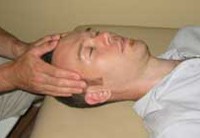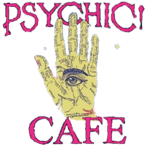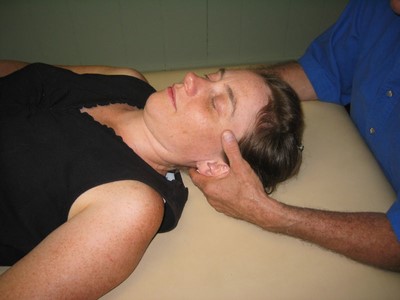Craniosacral therapy is a gentle, non-invasive, hands-on healing modality that focuses on the wave-like rhythmic pulse that goes through the entire body. This therapy stems from osteopathy, which is an approach that emphasizes the role of the musculoskeletal system in health and disease.
In a typical one- to two-hour session, the client lies quietly, fully clothed, while the practitioner makes light contact at selected points around the head, torso, knees, and feet. This light contact consists of gentle finger pressure, with no bone manipulation or forceful thrusts such as those used in chiropractic work, bone-setting, or osteopathy.
The practitioner notes what he or she perceives at selected points on the body and in the craniosacral system (the membranes and cerebrospinal fluid that surround and protect the brain and spinal cord), as well as the client’s attitude and intentions. The goal of craniosacral therapy is to help get rid of restrictions in this system to improve the functioning of the central nervous system.
How could it benefit health and wellbeing?
Some people use craniosacral therapy as an adjunct to other forms of treatment, including migraine headaches, chronic pain, chronic fatigue syndrome, post-traumatic stress disorder, trauma of any kind, post-surgical recovery, TMJ, and others.
Craniosacral therapy does no harm when practiced sensitively and respectfully by a trained practitioner. It may support an attitude shift in clients toward a more direct and intimate sense of their own wellbeing, a feeling of “being more at peace with oneself.” It may also support a natural shift to self-acceptance, a more natural capacity for loving relations, and a sense of being connected to life.
What is the cerebrospinal wave?
There is a great deal of debate and conjecture in the literature on craniosacral therapy on the nature of the cerebrospinal wave, or the cranio-rhythmic impulse, including:
- Where the pulse originates (this is not accounted for in the literature).
- Whether or not cranial bones move (classical anatomists generally believe that the cranial sutures fuse in adulthood; craniosacral practitioners, on the other hand, believe that the cranial sutures have motility).
- Whether or not there is a consistent, measurable pulse (there are various attempts to quantify the rate of cycles per minute of the craniosacral pulse, but so far they have been inconclusive).
- Whether or not the presence of the practitioner influences the pulse (this issue goes to the heart of the dichotomy between integrative and allopathic philosophies – our perspective is that it is naïve to think that we don’t affect what we observe, or touch, or to which we put our attention).
Where can I find a practitioner?

When choosing a practitioner, it is important to get references, but ultimately it’s up to you to find the person who “feels right to you.”
There are some online directories for craniosacral therapists.
Craniosacral therapy may or may not be covered under insurance. Providers typically need to be licensed in a particular specialty (for example, massage therapy, chiropractic, or physical therapy) in order for insurance overage.
The Psychic Café is proud to have one of the Bay’s top CranioSacral therapists there to meet you.





